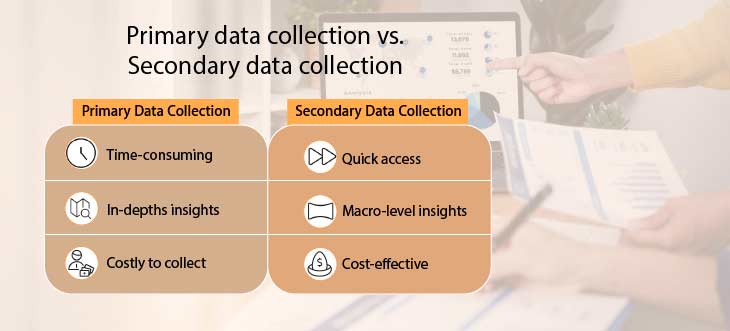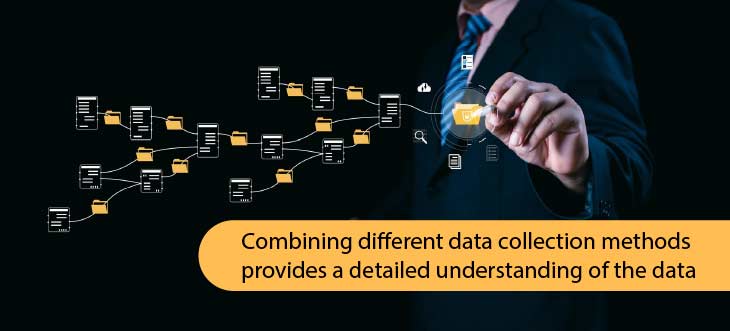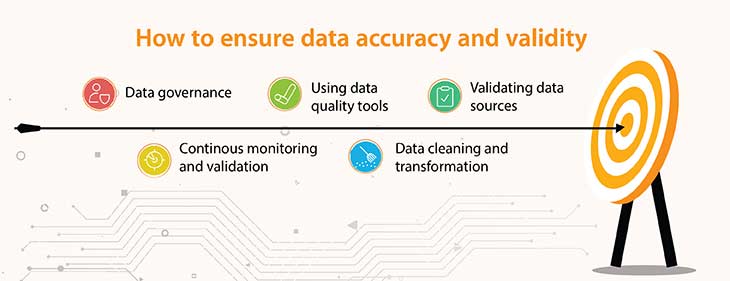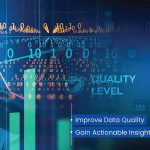Selecting appropriate data collection methods is crucial for market research success. Consider aligning methods with objectives and factors like data type and audience. Combining multiple methods, like surveys and interviews, ensures data accuracy and validity for informed decision-making.
Contents
- Understanding Types of Data Collection Methods
- Factors to Consider While Choosing the Right Data Collection Method
- Top Tools Used for Different Data Collection Methods
- Combining Data Collection Methods for a Holistic Understanding
- Data Collection from Websites for Market Research
- Tips for Ensuring Data Accuracy and Validity
- Moving Forward
To ensure the quality and relevance of your research, selecting the right data collection method is essential. When you use inappropriate data collection techniques, you risk generating inaccurate, incomplete or biased data, which ultimately impacts your research.
The key is to carefully consider the available types of data collection methods and choose those that best suit your research objectives and the nature of the data required.
For example, when exploring consumer opinions, qualitative methods like interviews or polls are often suitable. In contrast, to quantify market trends, consider surveys or statistical analysis.
By carefully considering the nature of your research and choosing the appropriate data collection techniques, you ensure that your data is reliable, valid and, ultimately, useful for drawing meaningful conclusions.
Understanding Types of Data Collection Methods

Understanding the diverse methods of data collection is crucial for selecting the appropriate one for your needs. Here, we discuss the various approaches to collecting both primary and secondary data.
Primary Methods of Data Collection
Primary data collection methods involve gathering firsthand information directly from the source.
Quantitative Approaches
Quantitative approaches focus on collecting numerical data. This allows us to measure and analyze trends. This answers questions like “How many?” or “How often?”
When analyzing data over time, we employ time series analysis. This involves collecting data points at consistent intervals to identify trends, cycles and seasonality, proving valuable for forecasting and understanding how variables change. For instance, analyzing website traffic data helps reveal peak seasons.
Smoothing techniques like moving averages or exponential smoothing help reduce noise and highlight underlying patterns, especially when dealing with volatile data.
To predict future trends, we utilize the barometric method. This involves tracking leading indicators (for example, building permits or consumer confidence indices) to anticipate market changes.
Qualitative Approaches
These aim to explore experiences and help understand the reasons behind behaviors and opinions. With qualitative research, we look for answers to questions like “Why?” or “How?”
Surveys gather structured data from large samples, revealing opinions and behaviors. They utilize diverse question formats, yielding both quantitative and qualitative insights.
Polls gauge public opinion on targeted topics and provide immediate feedback. For example, it helps understand customer preferences for a new product feature before its official launch.
In-depth interviews explore individual experiences and motivations, generating rich qualitative data. For instance, conducting interviews with users who have recently abandoned their online shopping carts helps understand usability issues for website redesign strategies.
Focus groups help uncover collective attitudes and beliefs within a target group. Systematically gathering and synthesizing expert opinions using the Delphi technique through iterative questionnaires promotes consensus.
Secondary Methods of Data Collection
When your research calls for data that’s already been gathered and compiled, secondary data collection sources offer a cost-effective and efficient solution. Here are some examples:
Public databases
Government agencies, such as the U.S. Census Bureau and the Small Business Administration, curate extensive databases. These resources encompass demographics, economic indicators and industry trends. You can generally access them for free to gain a macro-level understanding of various market landscapes.
Commercial market research reports
Specialized firms collect and analyze granular market data, segmenting them by industry, demographics and consumer behavior. These reports provide in-depth analysis, actionable insights and competitive advantage.
For instance, Nielsen reports offer data on consumer-packaged goods, including market share, brand loyalty and purchasing behavior.
Financial data sources
Publicly traded companies disclose their financial performance data through quarterly and annual reports. This allows you to analyze company performance, discern industry trends, and evaluate economic indicators.
Consider this data collection example – using SEC filings accessed through EDGAR, you can examine a company’s financial health and compare it to industry competitors.
Internal company documents
Sales reports and customer feedback surveys provide a wealth of information about customer behavior, product performance, and market trends. By mining this internal data, you uncover key insights into customer preferences, customer behavior, and identify areas of improvement within your own organization.
Online resources through web scraping services
Web scraping services allows you to directly extract data from websites. This helps gather data, such as product prices from e-commerce sites, news articles from online publications, or customer reviews, through techniques such as social media listening. This data helps you identify market trends, track competitor activities, or understand public opinion.
For example, if you’re researching the real estate market, you could scrape property listings from websites like Zillow or Redfin. This allows you to analyze trends in housing prices, property features, and location popularity to help your market analysis and investment strategies.
Robust Real Estate Data Collection Builds a Credible MLS for USA-Property Dealer

HabileData collected, standardized, and verified property data from over 1,350 sources for a U.S.-based real estate consultant. The process improved the accuracy of their MLS database, enhanced user experience, increased market presence and boosted brand credibility.
Read full case study »Boost your market research with our targeted data collection.
Get in touch »Factors to Consider While Choosing the Right Data Collection Method
Selecting the right data collection method requires understanding the following key factors. By carefully evaluating these factors, you can ensure that the data collection method you selected aligns with your business goals and resources.
Nature of Research
The research objective determines the data collection approach. Exploratory research, focused on understanding a phenomenon rather than testing a hypothesis, often utilizes qualitative methods like focus groups or in-depth interviews to gather rich, nuanced data.
On the other hand, conclusive research seeks definitive answers, often leveraging quantitative methods such as surveys and structured observations for statistically analyzable data.
Type of Data Needed
Data type dictates methodological choices. Quantitative data, often numerical, are ideal for measuring trends and identifying patterns. To obtain this data, employ large-scale surveys and structured questionnaires.
Qualitative data, on the other hand, offer a more profound understanding of consumer behavior and motivations. To better understand the “why” behind consumer actions, utilize focus groups, in-depth interviews, and ethnographic studies. Mixed-methods research combines both approaches for a comprehensive understanding.
Target Audience & Sample Size
Defining your target audience and determining the necessary sample size is crucial. For instance, for niche markets or exploratory research with smaller sample sizes, focus groups or in-depth interviews offer valuable insights.
Budget and Resources
Align your methodological choices with your budgetary constraints. Online surveys and data scraping offer cost-effective ways to gather data. While face-to-face interviews and focus groups require more resources, they yield richer, more nuanced data. Carefully balance cost considerations with the need for in-depth insights.
Time Constraints
Project timelines influence your choice of research methods. Longitudinal studies that track trends over time require a substantial time investment. If you need immediate insights, consider real-time data collection methods like social media monitoring or online surveys.
Top Tools Used for Different Data Collection Methods
It is crucial to choose the right tools for effective data collection in market research. The following table lists some top tools categorized by data collection methods:
| Data Collection Method | Tool | Use |
| Surveys | SurveyMonkey | Popular for its advanced features like branching logic and skip patterns. |
| Qualtrics | Offers robust survey design, distribution, and analysis capabilities, suitable for complex research needs. | |
| Interviews | Zoom | Facilitates online video conferencing for remote interviews, allowing for face-to-face interaction. |
| Otter.ai | Provides AI-powered transcription, making it easier to analyze interview recordings. | |
| Focus groups | Google Meet | Enables online focus group discussions with screen sharing and recording features. |
| FocusVision | Specializes in focus group management, including participant recruitment and video streaming. | |
| Observation and field data collection | dScout | Enables in-context research by capturing real-time customer experiences through mobile ethnography. |
| Lookback | Facilitates user experience research by recording user interactions and gathering feedback on digital products. | |
| Data analysis tools | SPSS | A powerful statistical analysis software for complex data analysis and modeling. |
| NVivo | A qualitative data analysis software for managing and analyzing textual data like interview transcripts. | |
| General data collection and management | Airtable | Combines spreadsheet and database functionalities for organizing and collaborating on data. |
| Google Sheets | For collaborative data collection, analysis, and visualization. |
Combining Data Collection Methods for a Holistic Understanding

To truly grasp the complexity of any phenomenon, consider combining data collection methods. This strategy allows you to harness the strengths of various approaches while mitigating their individual limitations. Here are some key techniques:
Sequential Explanatory Design
Begin by collecting quantitative data. Then, gather qualitative data to shed light on the initial results.
Instead of merely describing the “what” with qualitative data, delve into the “why” behind unexpected quantitative findings.
For instance, if a survey reveals an unexpectedly high satisfaction rate with a service, conduct follow-up interviews to understand the specific factors driving this satisfaction.
Sequential Exploratory Design
Reverse the approach by starting with qualitative data to explore a phenomenon. Subsequently, utilize quantitative data to generalize these findings to a larger population. Leverage the initial qualitative phase to develop a novel measurement tool or framework.
For example, conduct interviews to understand how individuals perceive “community well-being.” Use these insights to create a quantitative survey instrument for measuring this concept within a broader population.
Concurrent Triangulation Design
Gather both quantitative and qualitative data simultaneously. Compare these data to validate your findings and enhance the robustness of your conclusions.
Go beyond simple comparison and utilize the qualitative data to uncover the mechanisms driving the quantitative relationships. For instance, if a survey indicates a correlation between income and health, conduct interviews to understand how higher income contributes to better health outcomes (e.g., access to healthcare, healthier food choices).
Embedded Design
Nest one data collection method within another to provide a richer, more nuanced understanding of the phenomenon under investigation.
Utilize qualitative data to enrich a primarily quantitative study by capturing the “lived experiences” behind the numbers. For example, in a clinical trial evaluating a new drug, incorporate patient diaries or interviews to understand how the treatment impacts their daily lives and overall well-being.
Multiphase Design
Conduct multiple phases of data collection, with each phase informing the next, allowing for a dynamic and iterative research process. Employ a multiphase design to study a phenomenon over time, capturing both quantitative changes and qualitative shifts in perspectives.
For example, to study the impact of a new policy, we first collect quantitative data on key indicators. Then, conduct qualitative interviews to understand people’s perceptions. Finally, gather further quantitative data to track long-term trends and assess the lasting impact of the policy.
Data Collection of 309,000 Attorneys within 45 Days for B2B Data Aggregator

HabileData collected and standardized 309,000 attorney profiles for a U.S.-based data aggregator within 45 days, achieving 99.9% accuracy. The project enhanced the client’s operational efficiency by leveraging custom bots, macros, and manual workflows to gather attorney data from multiple sources.
Read full case study »Extract vital web data for smarter business decisions.
Contact our team »Data Collection from Websites for Market Research
For conducting market research, web scraping method has proven its worth in extracting publicly available data from websites. However, dynamic websites that rely heavily on JavaScript may pose challenges to this methodology.
Headless browsers and AJAX interception
To overcome these challenges, consider using headless browsers like Puppeteer or Playwright. These tools fully render web pages, including JavaScript execution, which streamlines data extraction. AJAX interception allows you to capture data from asynchronous requests.
Advanced extraction techniques
For precise targeting and extraction of specific data points within the HTML structure, employ advanced extraction techniques, such as XPath, CSS selectors, and regular expressions.
Anti-scraping measures and scaling
Websites often implement anti-scraping measures. To avoid detection, use IP rotation, which involves employing multiple IP addresses. If you encounter CAPTCHA challenges, consider using CAPTCHA solving services.
To scale your web data collection process, implement asynchronous requests for parallel processing, and distribute scraping tasks across multiple machines or servers.
Ethical and legal considerations
Always prioritize ethical and legal considerations. Respect the website’s robots.txt file, implement rate limiting to prevent overloading servers, and ensure compliance with data privacy regulations.
Tips for Ensuring Data Accuracy and Validity

Healthy data empowers you to make confident, data-driven decisions that propel your organization forward. The following are some data validation techniques to ensure accuracy and reliability of your collected data:
- Validating data sources and integrity: To ensure reliability, start by cross-referencing your data against known, reputable sources. Also, employ statistical techniques to pinpoint outliers.
- Data cleaning and transformation: Before analysis, take the time to standardize the data formats. Correct any obvious errors and address missing values strategically. You can achieve this through imputation or, if necessary, by deleting incomplete records.
- Using data quality tools: Leverage the power of specialized software designed for data quality management. These tools assist in profiling your data, cleansing it of errors, and continuously monitoring its overall health.
- Continuous monitoring and validation: Implement systems for continuous data quality checks, track key metrics like accessibility, reliability, validity and relevance that reflect data health, and set up automated alerts to notify you of any anomalies that may arise.
- Data governance: This involves clearly defining the roles and responsibilities related to data management and quality assurance. Implement standardized processes to ensure everyone understands how data should be handled and maintained.
Moving Forward
The future of data collection lies in the integration of AI and machine learning. These technologies allow for automating and personalizing data collection. Leveraging predictive analytics will help gain real-time insights and make more informed decisions.
Selecting the right data collection methods is crucial for successful market research. Top data collection companies consider research objectives, target audience, and available resources to choose the most effective methods to gather valuable insights and drive informed decision-making. It is extremely important to prioritize ethical considerations at the same time and ensure that your chosen data collection methods align with your overall research goals.
Analyze social media trends with powerful data collection.
Consult our experts »
Snehal Joshi heads the business process management vertical at HabileData, the company offering quality data processing services to companies worldwide. He has successfully built, deployed and managed more than 40 data processing management, research and analysis and image intelligence solutions in the last 20 years. Snehal leverages innovation, smart tooling and digitalization across functions and domains to empower organizations to unlock the potential of their business data.






